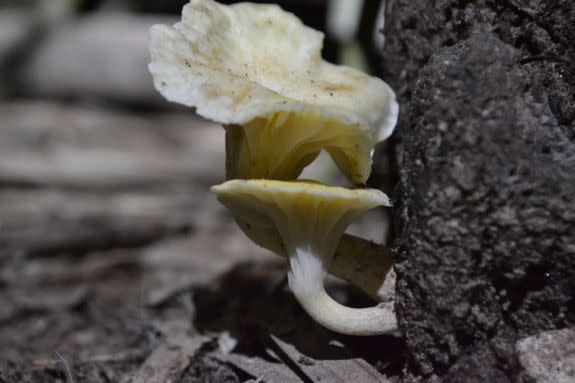Here's why these mushrooms glow in the dark

Dozens of glow-in-the-dark mushroom species grow around the world. But details on what makes them shine so bright have long been dim.
In a new study, scientists say they can finally explain what makes bioluminescent mushrooms glow. They describe a process of "enzyme promiscuity" that leads to changes in the intensity and colors of mushrooms' light emissions.
SEE ALSO: This frog's slime can destroy flu viruses
The researchers, who hail from Russia, Brazil, and Japan, published their findings Wednesday in the journal Science Advances.
Bioluminescence exists in a wide range of organisms, including deep sea fish, fireflies, and glowworms. In March, another group of scientists found the first solid evidence of fluorescence in amphibians, courtesy of the South American tree frog.

Image: Cassius V. Stevani/IQ-USP, Brazil
Of around 100,000 fungal species, about 80 are known to be bioluminescent.
Some of these emit a green light from within to attract beetles, flies, wasps, and ants, which in turn help disperse the mushrooms' spores and spread the fungi across the forest canopy, a 2015 study found.
Zinaida Kaskova and her colleagues analyzed the extracts of two such 'shrooms for their study: Neonothopanus gardneri, a fluorescent mushroom native to Brazil, and Neonothopanus nambi, a poisonous mushroom found in the rainforests of southern Vietnam.

Image: Cassius V. Stevani/IQ-USP, Brazil
In most cases of bioluminescence, living organisms emit light when a molecule called "luciferin" — from the Latin lucifer, which means light-bringer (also, Satan?) — combines with its enzyme partner "luciferase."
When luciferin and luciferase mix together with energy and atmospheric oxygen, it triggers a chemical reaction. The result is a very "excited" oxyluciferin, which releases light energy in order to "calm down" to its lowest energy state, the scientists explained.
Previous research has characterized the luciferin-luciferase combination in bioluminescent insects, bacteria, and marine mammals. But Wednesday's study is the first to describe this in fungi.

Image: Cassius V. Stevani/IQ-USP, Brazil
Kaskova, a researcher at the Russian Academy of Sciences' Institute of Bioorganic Chemistry, said she and her team were able to pinpoint the structure of oxyluciferin in fungi.
They found that fungal luciferase may be "promiscuous," in that it can potentially interact with multiple derivatives of the luciferin molecule in mushrooms.
Their findings could pave the way for scientists to harness bioluminescence in mushrooms. Scientists already use fluorescent molecules to track cells and proteins in biological research. This could add another tool for analytical and imaging technologies.
